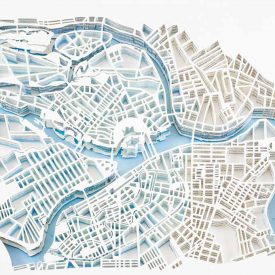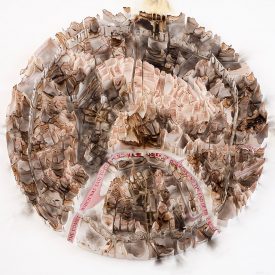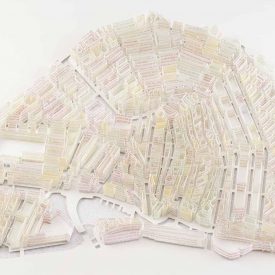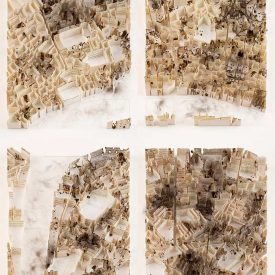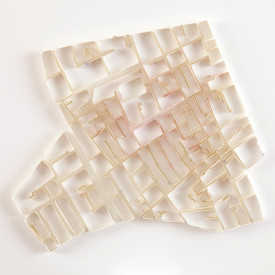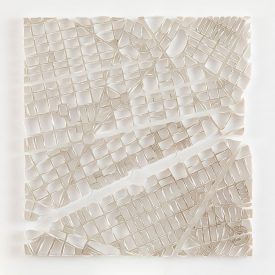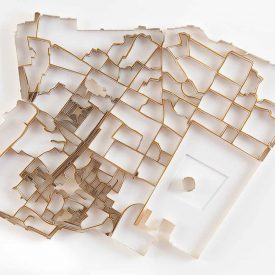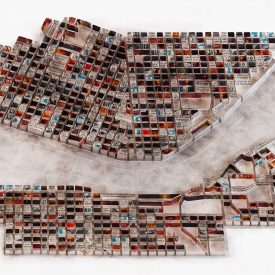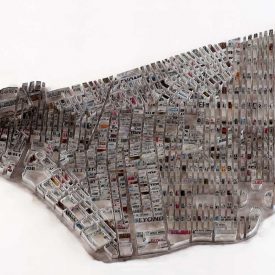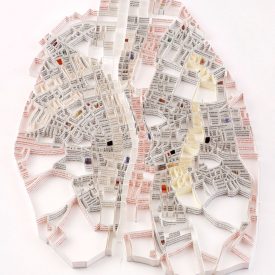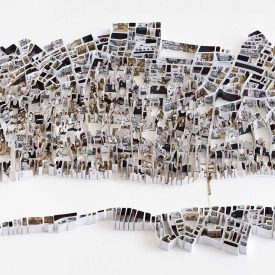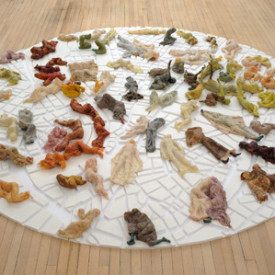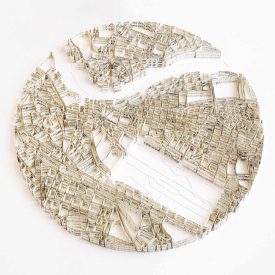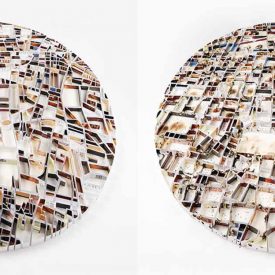archival absorbent paper, velum, archival ink, 2012 excerpts from LESS THAN ONE by Joseph Brodsky. Copyright c 1986 by Joseph Brodsky “Poem without a hero” from Poem without a hero and selected poems by Anna Akhmatova.
There are few cities in the world with such a remarkable literary heritage as St Petersburg and perhaps no other city with one in which the very city itself has been the primary subject matter. Through the written word St Petersburg developed an imagined mythological entity, each generation of writers adding and expounding upon the theme. The Petersburg myth started with the very beginning of it’s history. According to this myth the essence of the city is based upon the duality inherent in it’s nature. this duality determines the image of the city and the life and fate of it’s inhabitants. The city of St Petersburg can either be seen as a triumph of reason over nature, or as a crime against nature. It is emblematic of the force and will of the state over the individual, created as it was by Peter the Great in 1703 at the edge of the Baltic sea. The draining of the marshes and subsequent building cost many thousands of lives. Built as the historian Karamzin said on “tears and corpses” it became a huge cemetry. St Petersburg was always a contradiction at once both elegantly and stunningly beautiful, and dark and terrible; rich and squalid; rationally conceived, yet the focus of irrational forces and events; subject to countless floods, fires, revolutions and wars. not to mention pestilences and plagues.
Pushkin’s The Bronze Horseman takes up at the beginning of St Petersburg, pitting the fate of Evgenii against the might and power of the Czarist Russian state. The origination of the Petersburg mythos was with this poem, many writers, from Gogol to Akhmatova followed the thread of the themes of madness, destruction and the demonic, along with contemplations of the uncertain boundaries of reality, using the city as a backdrop. As Joseph Brodsky says ” The depiction of both the actual and mental interior of the city, of it’s impact on the people and their inner world, became the main subject of Russian literature almost from the very day of this city’s founding..technically speaking, Russian literature was born here, on the shores of the Neva”
The sculpture of St Petersburg uses texts from the Bronze Horseman by Pushkin, Poem Without a Hero by Akhmatova and A Guide To a Renamed City, by Joseph Brodsky. It also uses the score to Shostakovich’s 7th Symphony. Akhmatova’s poem looks back to the Bronze Horseman and incorporates by citation, reference and allusion works of many of the Russian writers from Pushkin onwards. The Bronze Horseman was written in 1833 and is set during the great flood of 1824. The sculpture is created from a map of the flood lines in St Petersburg in 1824. “In the Russian cultural sphere The Bronze Horseman and Poem without a hero form the two bases of a majestic arch, an imaginary space under which lies the Petersburg mythos” Solomon Volkov. The Poem without a hero reflects the fate of the city in the 20th Century, a line from the poem is as follows” Just as the future ripens in the past, so the past rots in the future” Akhmatova uses the past to tell the future, her own and the city’s. Solomon Volkov says ” Poem without a Hero brought the creation of a new Petersburg mythos to it’s culmination, one to which all Russian culture of the preceeding 250 years had contributed” Poem without a hero spans the period of 1940 to 1962. A time in which St Petersburg felt the force of the 20th Century, enduring both the siege by Germany from 1941 to 1944 and the ravages of Stalin’s “Great Terror” of the 1950s. The poem if prophetic in this regard ” But along the the Neva’s legendary esplanade, The Twentieth Century approached — Not the one on the calendar, the real one.” Akhamatova.
The music score used in this work is Shostakovich’s 7th symphony, written during the actual siege in which the city literally starved to death. The symphony was actually performed there during the siege, the city became the city of martyrs the city of suffering. The image of the Queen of spades in the sculpture refers to Tchaikovsky’s opera the Queen of Spades, itself based upon the novella of the same name by Pushkin. Joseph Brodsky carries the narrative forward beyond the war in “A guide to a renamed city” looking at the city from afar, from exile in New York, he re evaluates the history the city and it’s myths with the perspective of distance. The texts from “A guide to a renamed city are in English, the texts of The Bronze Horseman and the Poem without a hero are included in Russian and English texts, The Russian texts in the sculpture are situated in the areas that were not inundated by the floods. The sculpture contains many of the key dates in the history of the city, such as the dates of the renaming in 1914 to Petrograd, in 1924 it became Leningrad and in 1991 reverted back to St Petersburg, The floods of 1824 and the floods of 1924, the revolutions of 1905 and 1917.
